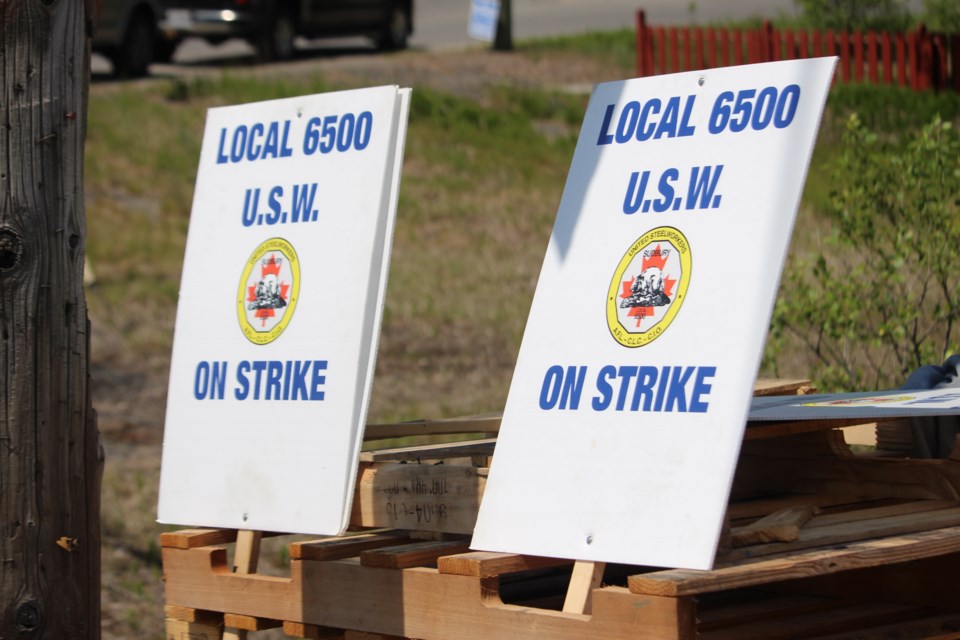The president of United Steelworkers Local 6500 said the union is preparing for the next bargaining session with Vale after rejecting the company’s offer on June 14.
In a June 22 post on the union’s website, he commended striking members of the union, who have been on the picket line since the beginning of June after rejecting Vale’s first offer.
“Your conduct on the picket line is first class,” Nick Larochelle said in his June 22 president’s report.
The union’s president said he was asked by Vale’s bargaining committee to come back with solutions for the next round of negotiations.
“I responded, you have our proposal — we delivered it on June 2, and once again on June 10. No changes to post retiree benefits for new hires, improvements to our wages, pension increases and better benefits for current active members.”
On June 14, the membership rejected Vale’s latest “concessionary” offer with a majority vote of 87 per cent.
Larochelle said in his report it is baffling that Vale is so set on maintaining its longstanding relationship with its benefits provider.
“It is baffling that Vale seems wedded to its longstanding benefits provider, Manulife, rather than seeking better service and results for its employees,” Larcholle wrote in his June 22 president’s report. “It makes no sense that a corporation supposedly concerned about financial results continues to accept such poor performance from the service provider.”
Larochelle said to justify attacking workers’ benefits, Vale continues to raise the “red herring” that “the ore bodies of yesterday are gone.”
He said rich reserves of nickel, copper, gold and ultra-valuable precious metals remain in existing mines and untapped ore bodies throughout the Sudbury Basin.
“These ore bodies will continue to produce for generations to come solely based on their composition,” said Larochelle. “Everyone knows that cuts to workers’ benefits are not the correct economic lever that will save these ore bodies.
“Given the current profitable performance of the Ontario operations ($800 million in 2020 and almost $340 million in the first quarter of 2021), combined with these right ore bodies in Sudbury, in addition to the projected increase in demand and price of nickel in the future, the company’s offer is out of tune with the economic context. There is no economic justification for the concessions being pushed by Vale.”
But during a June 17 town hall meeting, Dino Otranto, chief operating officer for its North Atlantic Operations and Asian Refineries, painted a less than rosy picture of Vale’s Sudbury operations.
The company said it's facing declining ore reserves in the Sudbury camp, a high cost of doing business, with the need to reinvest in operations, exploration drilling and development to find, prove up and access new sources of ore.
With ore reserves expected to run out at three mines over the next 10 years, Otranto said: "This is a hurdle that we must solve."
In the town hall discussion, a listener suggested Vale is making billions and employees are only seeking their fair share.
Both Otranto and Gord Gilpin, the company's North Atlantic head of processing, produced a pie chart indicating Vale's worldwide financial performance, its Ontario operations – meaning Sudbury – make up only two per cent of the Brazilian miner's business in 2020, slipping from five per cent in 2016.
"I'm not sure people really understand this message," said Otranto. "Two per cent is where we're at."
More than 90 per cent of the cash generated by Vale, globally, comes on the back of iron ore sales, followed by copper and then nickel, Otranto said.
"Here in Sudbury, we're only a part of that nickel story," he said, with other company mining operations in Thompson, Man., and Voisey's Bay, Labrador.
Vale's proven and probable mineral reserves in the Sudbury basin have dwindled from more than 100 million tonnes in 2011 to 50 million tonnes in 2020.
Otranto said mining companies operating in the Sudbury basin all face the same challenges. Ore bodies are deeper, are more seismically active, have lower grades, and have less platinum group metals and copper in the mix.
Vale's current operations in Sudbury will make up less than 15 per cent of the total operation looking out over the next 10 years.
Otranto also addressed the "hot topic" for Local 6500, namely Vale's current and future pension benefits obligations.
The company's post-retirement benefits obligations, as of Jan. 1, were running at US$868 million. That's scheduled to balloon to nearly $1.2 billion by 2040, growing at a rate, Otranto said, "that is out of our control.
"Think about that in relation to the two per cent (company-wide) that we earn."
Though respectful of the history of the contribution of Sudbury miners, he pleaded with employees to understand how the current structure of how retirement benefits are being administered puts them in a financial bind that negatively impacts the company's ability to source capital to invest in mines that are running out of ore.
"It's for my three boys and your children in this industry. This is a problem we need to solve."
Otranto said addressing the pension liability issue is "but one step to turning around this business."
